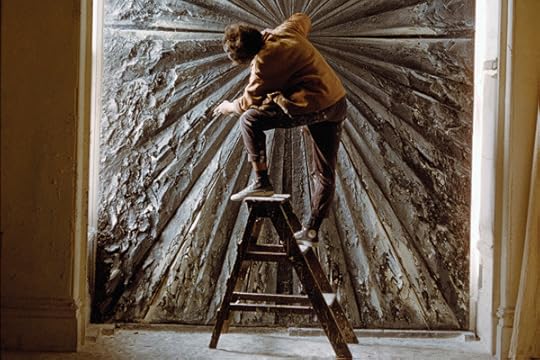Jay DeFeo's Rose -- and the Lesson We Should Learn From It
.

How powerful is a story? An article in the New Yorker about the artist Jay DeFeo sent me to the Whitney yesterday, to the first comprehensive overview of her work and life.
In brief: DeFeo was recognized as an artist of brilliance straight out of art school. Her stuff was good from the git-go. It got better and better, culminating in a group of large encaustic religious abstracts -- Veronica, The Jewel, Annunciation, and Incision -- which, for my money, established her as a great artist. Go and look at them, if you doubt me.
Then she started painting Deathrose (later The White Rose and finally The Rose), a culminative work which was meant to express something profound and spiritual.
She worked on it for nine years, building up boulders of paint and scraping them back down, sometimes right to the canvas. The only reason that she didn't keep on working on it until her death was that her landlord raised the rent, forcing her to move out. Also to have a wall torn out so her masterwork could be removed by crane.
This was an emotional time for DeFeo. She lost her husband, contracted gum disease, and stopped working.
For four years.
DeFeo eventually pulled herself together and proceeded to create work that was consistently interesting and often profound to her dying day. But consider this: She was a peer of Jasper Johns, Helen Frankenthaler, Ellsworth Kelly, Robert Rauschenberg a other artists who are household names today. Yet she is not.
The Rose is good, but overworked. The oils leading up to it are great. If DeFeo had refrained from obsessing over it, she might have produced a great work. At worst, it would have been a flop, which would have been quickly forgotten.
But DeFeo forged on, obsessively, trying to create something better than she was capable of, and in the course of it destroyed her career.
The moral, as it applies to writers, is, I hope, obvious.
*

How powerful is a story? An article in the New Yorker about the artist Jay DeFeo sent me to the Whitney yesterday, to the first comprehensive overview of her work and life.
In brief: DeFeo was recognized as an artist of brilliance straight out of art school. Her stuff was good from the git-go. It got better and better, culminating in a group of large encaustic religious abstracts -- Veronica, The Jewel, Annunciation, and Incision -- which, for my money, established her as a great artist. Go and look at them, if you doubt me.
Then she started painting Deathrose (later The White Rose and finally The Rose), a culminative work which was meant to express something profound and spiritual.
She worked on it for nine years, building up boulders of paint and scraping them back down, sometimes right to the canvas. The only reason that she didn't keep on working on it until her death was that her landlord raised the rent, forcing her to move out. Also to have a wall torn out so her masterwork could be removed by crane.
This was an emotional time for DeFeo. She lost her husband, contracted gum disease, and stopped working.
For four years.
DeFeo eventually pulled herself together and proceeded to create work that was consistently interesting and often profound to her dying day. But consider this: She was a peer of Jasper Johns, Helen Frankenthaler, Ellsworth Kelly, Robert Rauschenberg a other artists who are household names today. Yet she is not.
The Rose is good, but overworked. The oils leading up to it are great. If DeFeo had refrained from obsessing over it, she might have produced a great work. At worst, it would have been a flop, which would have been quickly forgotten.
But DeFeo forged on, obsessively, trying to create something better than she was capable of, and in the course of it destroyed her career.
The moral, as it applies to writers, is, I hope, obvious.
*
Published on March 22, 2013 00:00
No comments have been added yet.
Michael Swanwick's Blog
- Michael Swanwick's profile
- 546 followers
Michael Swanwick isn't a Goodreads Author
(yet),
but they
do have a blog,
so here are some recent posts imported from
their feed.



